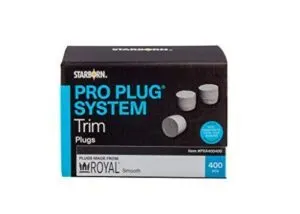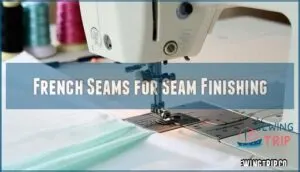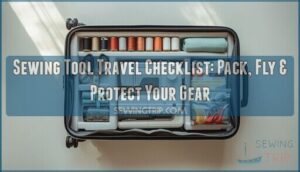This site is supported by our readers. We may earn a commission, at no cost to you, if you purchase through links.

You’ll want flexible trim materials like self-adhesive baseboards that bend around corners without cracking. Pneumatic brad nailers work better than hammers in confined areas, while adjustable miter saws help you cut precise angles when there’s barely room to swing a cat.
French seams and bias tape finishes create clean edges on fabric projects, and overlocking techniques prevent fraying in narrow spaces.
The trick isn’t forcing standard methods into impossible spots – it’s adapting your approach to work smarter, not harder.
Table Of Contents
Key Takeaways
- You’ll achieve professional results in cramped quarters by choosing flexible materials like self-adhesive baseboards and lightweight composite trim that adapt to tight spaces without cracking or splitting.
- You can master precision cuts in confined areas using pneumatic brad nailers instead of hammers and adjustable miter saws that work efficiently where there’s barely room to maneuver.
- You’ll prevent fraying and create clean edges on fabric projects by using French seams, bias tape finishes, and overlocking techniques specifically designed for narrow seam allowances.
- You should focus on adapting your approach rather than forcing standard methods into impossible spots—work smarter by selecting tools and techniques that match your space constraints to achieve successful projects.
Narrow Seam Finishes
Narrow seam finishes are all about creating clean, durable edges in tight spaces where precision matters most.
They help prevent fraying, guarantee longevity, and offer a polished look for your projects.
What is a Narrow Seam Finish
A narrow seam finish is a sewing technique designed for tight space sewing, using a small seam allowance to create clean, durable edges.
Master tight spaces with precision—small seam allowances deliver clean, durable edges every time.
It’s ideal for delicate fabrics like silk or organza, where an enclosed seam finish prevents fraying.
By adjusting stitch length, tension settings, and needle choice, you can achieve precise results, even with challenging fabric types, and create a durable edge.
Benefits of Narrow Seam Finishes
When working in tight spaces, narrow seam finishes shine by maximizing space optimization and ensuring durability increase.
They’re cost-effective, reducing fabric waste from small seam techniques. Plus, they enhance aesthetic appeal with clean, polished edges.
One example includes using French seams for delicates.
Seam finishes also offer versatile applications, adapting to various fabrics and projects, making them indispensable for tight space sewing and narrow seam allowance tasks.
Common Uses of Narrow Seam Finishes
You’ll find narrow seam finishes handy for enhancing durability and preventing frays in garments, especially with delicate fabrics like silk or chiffon.
These small seam techniques are perfect for tight spaces, ensuring fabric compatibility and extending garment lifespan.
Plus, they offer aesthetic appeal, making seam finishes a go-to for sewing techniques that balance practicality and style effortlessly, providing a solution that enhances durability.
Top 6 Narrow Seam Solutions
When working in tight spaces, you need tools and techniques that deliver precision without added bulk. These six solutions will help you achieve seamless finishes efficiently and effectively.
1. Royal Trim Plugs for Smooth Trim

Royal Trim Plugs are a game-changer for achieving smooth, professional trim finishes.
Made from durable polyvinyl chloride, these plugs are lightweight, moisture-resistant, and easy to install—perfect for DIYers and pros alike.
Whether you’re tackling wainscoting or baseboard projects, they guarantee a seamless look by concealing screws and gaps effortlessly.
Pair them with PVC trim for a modern, clean aesthetic. Just remember to store them in a cool, dry spot to maintain quality.
With 400 in a pack, you’ll have plenty for any project, making Royal Trim Plugs a valuable resource.
Best For: DIY enthusiasts and professionals seeking a durable, moisture-resistant solution for smooth trim finishes.
- Lightweight and easy to install.
- Moisture-resistant and durable material.
- Comes in a pack of 400, ideal for large projects.
- Requires proper storage in a cool, dry place.
- Compatibility needs to be checked with specific materials.
- Not suitable for non-trim applications.
2. WEN 18 Gauge Pneumatic Brad Nailer
Your nail gun becomes a precision instrument when you choose the WEN 61721 18-gauge pneumatic brad nailer. This lightweight powerhouse shoots brads from 3/8 to 2 inches, making it perfect for delicate trim work in cramped quarters.
You’ll appreciate its depth adjustment wheel and quick-release magazine that holds 106 nails. The rubber-lined handle reduces fatigue during extended use, while the hassle-free nose latch clears jams instantly.
Operating at 60-115 PSI, it’s delivered over 10,000 fasteners without issues for many users, making it a reliable choice for your projects with its precision instrument capabilities.
Best For: DIY enthusiasts and woodworkers who need a reliable, lightweight nailer for trim, baseboards, and small projects.
- Shoots 18-gauge brads ranging from 3/8 to 2 inches in length.
- Lightweight design with a rubber-lined handle for reduced fatigue.
- Features like depth adjustment and quick-release magazine add convenience.
- Nails and carrying case not included.
- Minor issue with nails occasionally sticking out, requiring extra hammering.
- Requires an air compressor to operate.
3. Self Adhesive Flexible White Baseboard Trim
For tight spaces where traditional molding won’t work, self-adhesive flexible white baseboard trim becomes your best friend.
You’ll love how this vinyl solution bends around corners and irregular surfaces without cracking or splitting.
The strong adhesive backing means you can skip the nail gun entirely—just peel, stick, and press firmly.
It’s perfect for curved walls, uneven floors, and rental spaces where you can’t drill holes.
The scratch-resistant surface cleans easily, and the flexible material adapts to any surface imperfection seamlessly.
Best For: Renters, DIY enthusiasts, and those needing a quick, tool-free solution for uneven or curved surfaces.
- Easy, tool-free installation with self-adhesive backing.
- Flexible material adapts to corners and irregular surfaces.
- Scratch-resistant and easy-to-clean vinyl surface.
- Not ideal for high-traffic areas because of material softness.
- Appearance can seem thinner than traditional baseboards.
- Some users may find it more affordable in hardware stores.
4. CRAFTSMAN Adjustable Angle Hand Miter Saw
When you’re working in cramped quarters, the CRAFTSMAN Adjustable Angle Hand Miter Saw becomes your precision ally.
This 6.98-pound tool delivers clean cuts for baseboards and casings without requiring electricity or bulky equipment.
You’ll appreciate its steel construction and 12-inch blade for smooth strokes through trim materials.
While it handles small projects beautifully, don’t expect it to power through thick molding like a corded saw.
The adjustable miter box guarantees accurate angles, though you might notice slight wiggle during cuts.
Perfect for occasional DIY trim work.
Best For: Beginners or DIY enthusiasts working on light woodworking projects and trim adjustments.
- Blade dulls quickly with regular use.
- Slight wiggle affects cutting accuracy.
- Rubber feet lack stability without extra clamping.
- Sturdy steel construction for durability.
- Smooth blade strokes for clean cuts.
- Adjustable miter box for flexible angle precision.
5. Romeda Sanding Sponges Assorted Grit Pack
Perfect corners demand flawless prep work, and these versatile sanding sponges deliver exactly that.
You’ll get eight blocks featuring four essential grits—60, 80, 120, and 220—color-coded for quick identification.
Their flexible foam construction bends around trim curves and tight angles where standard sandpaper fails.
The tear-resistant material withstands repeated washing, making them cost-effective for multiple projects.
Whether you’re smoothing drywall patches or prepping baseboards for paint, these conformable sponges reach every nook without leaving scratches on delicate surfaces.
Best For: DIY enthusiasts, crafters, and professionals needing versatile, reusable sanding solutions for smooth finishes on various projects.
- Some users find it challenging to fully clean debris off the sponges.
- May not be suitable for very large or heavy-duty sanding tasks.
- Limited to the provided grit range without ultra-fine or extra-coarse options.
- Includes four essential grit options, color-coded for easy identification.
- Flexible foam construction conforms to curved or tight areas.
- Washable and reusable, offering durability and cost savings.
6. Bona Multi-Surface Sweep and Clean Mop
Maintaining pristine seam lines becomes effortless when you’re equipped with the right cleaning tools.
The Bona Multi-Surface Sweep and Clean Mop transforms your finishing routine with its telescoping pole that extends from 34 to 52 inches, reaching every corner without strain.
You’ll appreciate the rubberized corners that protect your freshly installed trim while the dual-zone microfiber pads capture dust and debris effectively.
Regular maintenance can prevent machine performance issues.
This 3-in-1 tool sweeps, cleans, and polishes, making post-installation cleanup a breeze in those challenging tight spaces, ensuring effortless maintenance of your space.
Best For: Homeowners or renters who need a versatile, sustainable mop for cleaning various floor types efficiently.
- 3-in-1 functionality for sweeping, cleaning, and polishing.
- Adjustable telescoping pole accommodates different heights.
- Washable and reusable microfiber pads reduce waste.
- Some users find it slightly heavy for extended use.
- Mixed feedback on handling in small spaces.
- Product is not returnable according to one review.
Choosing Right Trim Materials
When you’re working with narrow seam finishes in tight spaces, the material you choose determines both the installation process and the final appearance.
Composite materials like PVC and polyurethane offer the durability you need while remaining lightweight enough to handle easily, making them ideal for spaces where traditional wood trim would be too bulky or difficult to maneuver.
Composite Options for Trim
In tight spaces, composite materials offer game-changing solutions for your trim work.
PVC trim and fiber-reinforced composites deliver superior moisture resistance while maintaining clean seam finishes.
These lightweight composites from trusted composite brands like AZEK resist warping and splitting, making them perfect for small spaces where traditional wood might fail.
Explore composite trim options for enhanced durability. You’ll love their durability.
Lightweight Alternatives for Trim
When weight matters most, polyurethane trim weighs just 1-2 pounds per 8-foot section compared to traditional wood’s 6-8 pounds.
EPS baseboards offer similar savings while adhesive vinyl provides instant architectural detail without nails or screws.
For delicate projects, consider using cotton thread to avoid unwanted bulk.
Easy installation options include:
- Peel-and-stick polyurethane moldings for rental-friendly updates
- Click-together baseboards requiring no cutting or measuring
- Flexible PVC trim bending around curved walls effortlessly
- Foam-core composite options offering professional appearance
Seam Finishing Techniques
You’ll need reliable seam finishing techniques to guarantee your narrow trim installations remain secure and professional-looking over time.
These methods prevent fabric edges from fraying and create clean, durable connections that withstand daily wear in tight spaces where precision matters most, ensuring professional-looking results.
Overlocking Techniques for Seam Finishing
Overlocking transforms your narrow seam finishes with professional precision.
You’ll master Serger Threading and Overlock Tension settings for clean edges that won’t fray. The Differential Feed prevents puckering on delicate fabrics, while Flatlock Stitch creates smooth, durable joins.
Your serger handles both 3-thread and 4-thread overlocking techniques, making sewing techniques effortless for tight spaces.
Selecting the correct method, like a French seam finish, is essential for delicate fabrics.
Zigzag Stitch Method for Seam Finishing
When your sewing machine’s zigzag stitch becomes your seam finishing hero, you’ll tackle narrow seams like a pro.
This versatile technique prevents fraying while maintaining fabric flexibility.
You can find various zigzag stitch products online.
- Stitch width: Set between 2-4mm for ideal coverage without bulk
- Stitch length: Use 1.5-2.5mm for balanced density and durability
- Needle selection: Choose appropriate size based on fabric type and weight
- Tension settings: Adjust to prevent puckering on delicate materials
French Seams for Seam Finishing
French seams create the cleanest finish for narrow seams by encasing raw edges completely within the stitching.
This sewing technique offers superior strength advantage and bulk reduction compared to other seam finishes.
You’ll sew twice—first with wrong sides together, then fold and stitch right sides together.
Perfect fabric choice for lightweight materials where visible seams need clean finish seams.
This is especially useful for delicate sheer fabrics that need a professional finish.
Bias Tape Finish for Seam Finishing
Bias tape finish transforms raw edges into polished, professional-looking seams that won’t fray.
You’ll wrap fabric strips around seam allowances, creating clean finish seams perfect for narrow spaces.
Double-fold bias tape works best for binding curved edges, while the bias facing method handles straight lines beautifully.
For preventing fraying, consider zigzag stitch techniques.
Mitered bias corners add that extra touch of craftsmanship to your projects, making them look more professional.
Trim Placement Strategies
Strategic trim placement transforms cramped spaces by creating visual lines that guide the eye and maximize perceived room dimensions.
You’ll achieve professional results by positioning vertical elements like floor-to-ceiling panels and horizontal features such as chair rails to establish proportional balance throughout your narrow areas.
Vertical Trim Elements for Visual Interest
Vertical trim transforms cramped spaces into stunning showcase rooms.
You’ll achieve maximum Visual Height by installing floor-to-ceiling panels with 12-16 inch Panel Spacing.
Choose 2-inch Trim Width for perfect proportions without overwhelming narrow areas.
These Material Choices create dramatic Accent Walls that draw eyes upward.
Think of it as architectural magic – vertical lines trick perception, making ceilings appear taller while adding sophisticated detail to any room, creating a sense of architectural magic.
Horizontal Lines for Trim Placement
How do horizontal lines transform cramped rooms into visually expansive spaces? Strategic placement creates the illusion of width while maintaining functionality in small spaces.
Your trim work should emphasize these horizontal continuity principles:
- Position chair rail height at 28-32 inches for ideal visual balance
- Install picture rail uses near ceiling line for spacesaving storage solutions
- Apply wainscoting styles with consistent trim alignment across connecting walls
- Maintain horizontal lines through coordinated seam finishes
Continuous Trim for Visual Continuity
Creating visual flow throughout your home requires consistent profiles that tie rooms together seamlessly.
When you maintain the same baseboard and crown molding dimensions across connected spaces, you achieve unified aesthetics that make small spaces feel larger.
This cohesive design approach eliminates jarring shifts between rooms, allowing your eye to travel smoothly through continuous trim work that enhances overall harmony.
Window Casings for Aligned Heights
You’ll achieve perfect Visual Continuity by aligning your window casing heights with horizontal elements like chair rails and baseboards.
Keep Consistent Trim Profiles throughout connected small spaces – this creates seamless flow between rooms.
Your Window Trim Styles should match door casings for unified appearance.
Proper casing height alignment transforms choppy trim work into polished design, making tight spaces feel larger and more cohesive.
Frequently Asked Questions (FAQs)
Why should you choose the right seam finish?
Like choosing the right foundation for your house, selecting proper seam finishes prevents fraying, guarantees durability, and creates professional results that’ll last through countless washes and wear cycles.
What are the different types of seam finishes?
You’ll encounter several seam finish types: zigzag stitching prevents fraying, French seams enclose raw edges completely.
Overlock techniques trim simultaneously, bias tape binding adds durability.
Pinking shears create zigzag cuts that minimize unraveling.
What is a seam finish?
The devil’s in the details," as they say.
A seam finish is your protective technique that prevents fabric edges from fraying and unraveling.
You’ll apply these methods after sewing to guarantee your seams stay durable and professional-looking.
What are smart seam finishes?
Smart seam finishes combine efficiency with durability, using techniques like mock French seams, zigzag stitching, or serged edges.
You’ll save time while preventing fraying, choosing methods that match your fabric type and project needs perfectly.
Using techniques like mock French seams will help you achieve the desired outcome.
Is there a one-size fits all seam finish?
No universal seam finish exists because fabric types, project requirements, and available tools vary substantially.
You’ll need different approaches for knits versus wovens, lightweight versus heavy fabrics, and whether you’re using a serger or regular machine.
What are the best seam finishes for beginners?
Starting your sewing journey doesn’t require mastering every technique immediately.
You’ll find zigzag stitching and pinking shears offer foolproof results.
These forgiving methods prevent fraying while building confidence before tackling more advanced French seams later.
What is the smallest seam allowance?
You can sew seams as narrow as 1/8 inch, though 1/4 inch is more practical for beginners.
Ultra-narrow seams require steady hands, sharp needles, and slower stitching speeds to maintain accuracy and prevent puckering.
What is bound seam finishing?
Bound seam finishing wraps raw edges with bias tape or fabric strips, creating a clean, professional look.
You’ll fold the binding over both seam allowances, then stitch through all layers for complete edge encasement.
What can I use to hide seams?
Like a magician’s sleight of hand, you can conceal seams using bias tape, decorative ribbon, or contrasting fabric strips.
Try strategic topstitching, appliqué patches, or even strategically placed buttons to transform visible seams into design features.
What are French seams?
French seams enclose raw edges completely within the seam itself, creating a clean, professional finish.
You’ll sew twice—first wrong sides together, then right sides—eliminating fraying while adding durability to your project.
Conclusion
Mastering narrow seam finishes for tight spaces isn’t rocket science—it’s about choosing the right tools and techniques for each unique challenge.
You’ve now got six proven solutions that’ll transform cramped quarters from frustrating obstacles into manageable projects.
Whether you’re working with flexible baseboards, pneumatic nailers, or specialized sewing techniques, these narrow seam finishes for tight spaces will deliver professional results every time.
Remember, the key lies in adapting your approach rather than forcing standard methods into impossible situations, to achieve unique challenge solutions.
- http://www2.ca.uky.edu/agcomm/pubs/fcs2/fcs2304/fcs2304.pdf
- https://www.threadsmagazine.com/project-guides/learn-to-sew/keep-these-seam-finishes-in-your-bag-of-tricks
- https://www.doinaalexei.com/sewing-a-self-bound-seam-finish.html
- https://www.royalbuildingproducts.com/liveabode/how-to-install-wainscoting-trim-to-your-textured-walls/
- https://www.youtube.com/watch?v=UdAUEqRyWto















